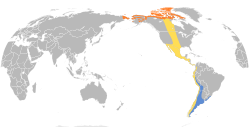| Baird's sandpiper | |
|---|---|
 | |
| Baird's sandpiper (Calidris bairdii) | |
| Scientific classification | |
| Kingdom: | Animalia |
| Phylum: | Chordata |
| Class: | Aves |
| Order: | Charadriiformes |
| Family: | Scolopacidae |
| Genus: | Calidris |
| Species: | C. bairdii |
| Binomial name | |
| Calidris bairdii (Coues, 1861) | |
 | |
| Range Breeding Nonbreeding Passage | |
| Synonyms | |
Actodromus bairdii | |
Baird's sandpiper (Calidris bairdii) is a small shorebird. It is among those Calidris species which were formerly sometimes included in the genus Erolia, which was subsumed into the genus Calidris in 1973. [2] The genus name is from Ancient Greek kalidris or skalidris, a term used by Aristotle for some grey-coloured waterside birds. The English name and specific bairdii commemorate Spencer Fullerton Baird, 19th-century naturalist and assistant secretary of the Smithsonian Institution. [3]


